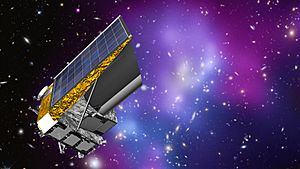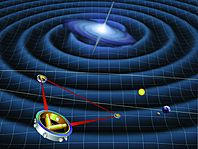European Space Agency Science Programme facts for kids
The Science Programme is a big plan by the European Space Agency (ESA). It helps create and launch amazing missions into space. These missions explore space and learn more about science.
This programme is managed by ESA's science team. They fund the creation, launch, and operation of space missions. These missions are often led by European space groups.
Over the years, the programme has had different big plans. The first was called Horizon 2000. It helped develop eight missions between 1985 and 1995. These included important ones like SOHO, Cluster II, XMM-Newton, Rosetta, and Herschel.
Then came Horizon 2000 Plus (1995-2005). This plan helped create Gaia, LISA Pathfinder, and BepiColombo.
Since 2005, the current plan is called Cosmic Vision. It has funded ten missions so far. These include big ones like JUICE, Athena, and LISA. ESA also works with other space agencies sometimes. For example, they teamed up with NASA for Cassini–Huygens. They also work with the CNSA (China National Space Administration) on SMILE.
Contents
Cosmic Vision: Exploring the Universe
Cosmic Vision 2015–2025 is ESA's current long-term plan for space science. It started in 2004 when ESA asked for new ideas. A workshop was held in Paris to decide the main topics. These topics covered astronomy, astrophysics, Solar System exploration, and basic physics.
By 2006, a 10-year plan was ready. It focused on four key questions:
- What do planets need to form, and how does life begin?
- How does our Solar System work?
- What are the basic rules of physics in the Universe?
- How did the Universe start, and what is it made of?
In 2007, ESA officially asked for mission ideas. They received many proposals. These included ideas for studying space, physics, and our Solar System.
Large Missions (L-class)
Large class (L-class) missions are very big projects. They were first meant to be done with other partners. But now, ESA often leads these missions. They might have some help from other countries.
Three L-class missions have been chosen for Cosmic Vision:
- JUICE: This mission will orbit Jupiter and its moon Ganymede. It is planned to launch in 2023.
- Athena: This is an X-ray observatory. It is planned to launch in 2034.
- LISA: This space observatory will look for gravitational waves. It is planned to launch in 2037.
Medium Missions (M-class)

Medium class (M-class) projects are also important missions. They are usually stand-alone projects.
The first two M-class missions were chosen in 2011:
- Solar Orbiter: This mission will get very close to the Sun. It will study the Sun's outer atmosphere.
- Euclid: This space telescope will study dark energy and dark matter.
PLATO was chosen in 2014. It will search for exoplanets (planets outside our Solar System). It will also measure how stars shake.
ARIEL was selected in 2018. This space observatory will look at exoplanets as they pass in front of their stars. It will figure out what they are made of.
The EnVision Venus orbiter was chosen in 2021. It will study the planet Venus. It is planned to launch in 2031.
Small Missions (S-class)
Small class (S-class) missions are smaller projects. They cost less than the larger missions.
The first S-class mission was CHEOPS. It was chosen in 2012. CHEOPS searches for exoplanets by looking at changes in starlight.
SMILE was chosen in 2015. It is a joint mission with the Chinese Academy of Sciences. SMILE will study how Earth's magnetic field interacts with solar wind. It is set to launch in 2024.
Fast Missions (F-class)
Fast class (F-class) missions are a newer type of mission. They are designed to be selected and launched quickly. They usually take less than ten years from idea to launch. These missions are often launched alongside M-class missions. They focus on new and exciting science topics.
The first F-class mission, Comet Interceptor, was chosen in 2019. It will visit a comet that has not been seen before. Another F-class mission, ARRAKIHS, was announced in 2022.
Missions of Opportunity
Sometimes, ESA helps with space missions led by other space agencies. These are called "Missions of Opportunity." They allow ESA scientists to join in on exciting projects without leading them. This is a good way to participate at a lower cost.
ESA has contributed to missions like Hinode, ExoMars, and MMX.
Voyage 2050: The Future of Space Exploration
The next big plan for ESA's science programme is Voyage 2050. This plan will guide space missions from 2035 to 2050. Planning for this exciting future began in 2018.
Voyage 2050 expects to have three Large class and six or seven Medium class missions. It will also include smaller missions. In 2021, the plan suggested some main science themes for the next big missions:
- Moons of Giant Planets: A mission to an "ocean-bearing" moon of a gas giant planet. These moons might have liquid water under their icy surfaces.
- Exoplanets and the Milky Way: A mission to study exoplanets or learn how our galaxy, the Milky Way, formed.
- Early Universe: A mission to explore the very early Universe. This could involve studying the cosmic microwave background or gravitational waves.
Timeline

See also
- List of European Space Agency programs and missions
- List of Solar System probes
- List of space telescopes
- Living Planet Programme





